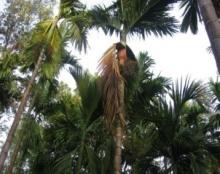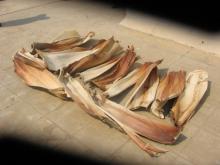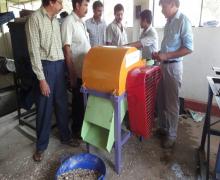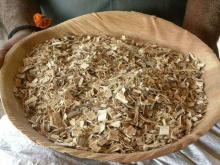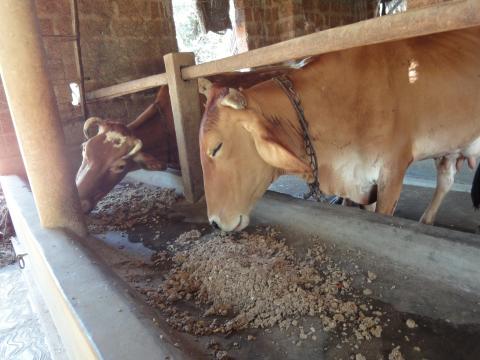Areca sheath as an alternate dry fodder for livestock
By N.K.S. Gowda, National Institute of Animal Nutrition and Physiology, Bengaluru 560 030, India
Introduction
Of late in many regions of India, the cultivation of cereal crops such as paddy is decreasing and instead horticultural crops e.g. areca nut, banana and spices are being grown due to higher economic returns. Besides India, the areca nut cultivation is common in parts of tropical Pacific, Asia and east Africa. Over the years, in Karnataka, Kerala and Assam states of India, the areca nut (Areca catechu) cultivation (Photo 1) as a commercial crop has increased at the cost of paddy and other cereals.
The areca nut is used by human population for chewing along with betel leaves (locally called as ‘paan’). This has led to deficiency of dry fodder in these areas, resulting in high price for paddy straw transported from adjoining districts, particularly in coastal zones of Karnataka, India. The fallen areca sheath is available seasonably (November to June) in sizeable quantity. Areca sheath, as an alternate resource, has been evaluated for use as a fodder. The areca sheath is generally used as fire-wood and in the preparation of catering/serving plates by the hotel industry. The potential availability of areca sheath in India is about 500 thousand tonnes per year.
Composition and nutritional value
Studies have shown that the chemical composition and nutritional composition of areca sheath are almost similar to those of the paddy straw. The contents of some minerals like calcium, copper and sulfur are higher in areca sheath (Table 1).
Areca sheath also contains low levels of oxalic acid and tannins.
Table 1: Areca sheath composition
| Parameter (DM basis) | Areca sheath | Paddy straw |
|---|---|---|
| Crude protein (%) | 3.5 | 3.8 |
| Ether extract (%) | 0.07 | 0.10 |
| Ash (%) | 6.4 | 17.1 |
| Silica (%) | 3.3 | 13.6 |
| Neutral detergent fibre (%) | 71.3 | 71.2 |
| Acid detergent fibre (%) | 47.7 | 51.1 |
| Lignin (%) | 3.9 | 5.1 |
| Metabolisable energy (MJ) | 7.52 | 7.31 |
| Total digestible nutrients (%) | 49.3 | 48.2 |
| Oxalic acid (%) | 0.34 | 0.56 |
| Tannin (%) equivalent to tannic acid | 0.40-0.89 | 0.73-1.03 |
| Calcium (%) | 0.25-0.60 | 0.16-0.28 |
| Phosphorus (%) | 0.06-0.08 | 0.06-0.07 |
| Magnesium (%) | 0.30-0.49 | 0.11-0.13 |
| Sulfur (%) | 0.61-0.75 | 0.25-0.35 |
| Copper (ppm) | 15-23 | 5-7 |
| Zinc (ppm) | 8-12 | 6-8 |
| Iron (ppm) | 90 | 211 |
| Manganese (ppm) | 45 | 40 |
| Cobalt (ppm) | 2 | 1.5 |
Processing
Due to its long and wider surface area (Photo 2), the areca sheath as such cannot be eaten by animals.
Therefore, it needs to be shredded to smaller pieces of about 2 x 10 mm size (Photos 3 & 4).
Livestock feeding
When compared to paddy straw, higher digestibilities of dry matter and fibre were observed on feeding shredded areca sheath to sheep as a dry fodder; and no adverse effects were observed.
The National Institute of Animal Nutrition and Physiology (NIANP) in Bengaluru, India has developed a technology for using dried and shredded areca sheath in the form of total mixed ration (TMR: Crude protein 13%, Total digestible nutrients 58%) along with suitable proportion of concentrate mixture to support milk production. With the support of the National Bank for Agriculture and Rural Development (NABARD) under Rural Innovation Fund scheme ,a model shredding unit of areca sheath has been installed in a milk producers cooperative, in Panaje near Puttur in Dakshina Kannada district of Karnataka, India. The dairy farmers of this region have shown a keen interest in this technology. The technology to process the areca sheath has been demonstrated to dairy farmers of this milk society. Feeding processed areca sheath to lactating animals, replacing paddy straw, has proved an economic value. On the technical guidance of NIANP scientists, the dairy farmers in Karnataka region have started using shredded areca sheath as a component of total mixed ration (Photo 5).
Using this technology has reduced the cost of feeding dry fodder and also increased milk yield by 7-10% and milk fat by 0.2-0.3 units. Recently the Karnataka Milk Federation has set up five more such units in areca growing regions and many farmers, on their own, have procured the shredding machine. Malbar milk union from Kerala and Non-Governmental Organizations from Andamon & Nicobar islands have shown interest in adopting this technology in their regions to mitigate the shortage of dry fodder.
Further reading
Gowda, N. K. S., Anandan, S., Pal, D. T., Vallesha, N. C., Verma, S., Sampath, K. T. , 2012. Technology to use areca sheath as an alternate dry fodder for dairy animals – A Success story. Indian Dairyman, 64 (10): 58-61.


